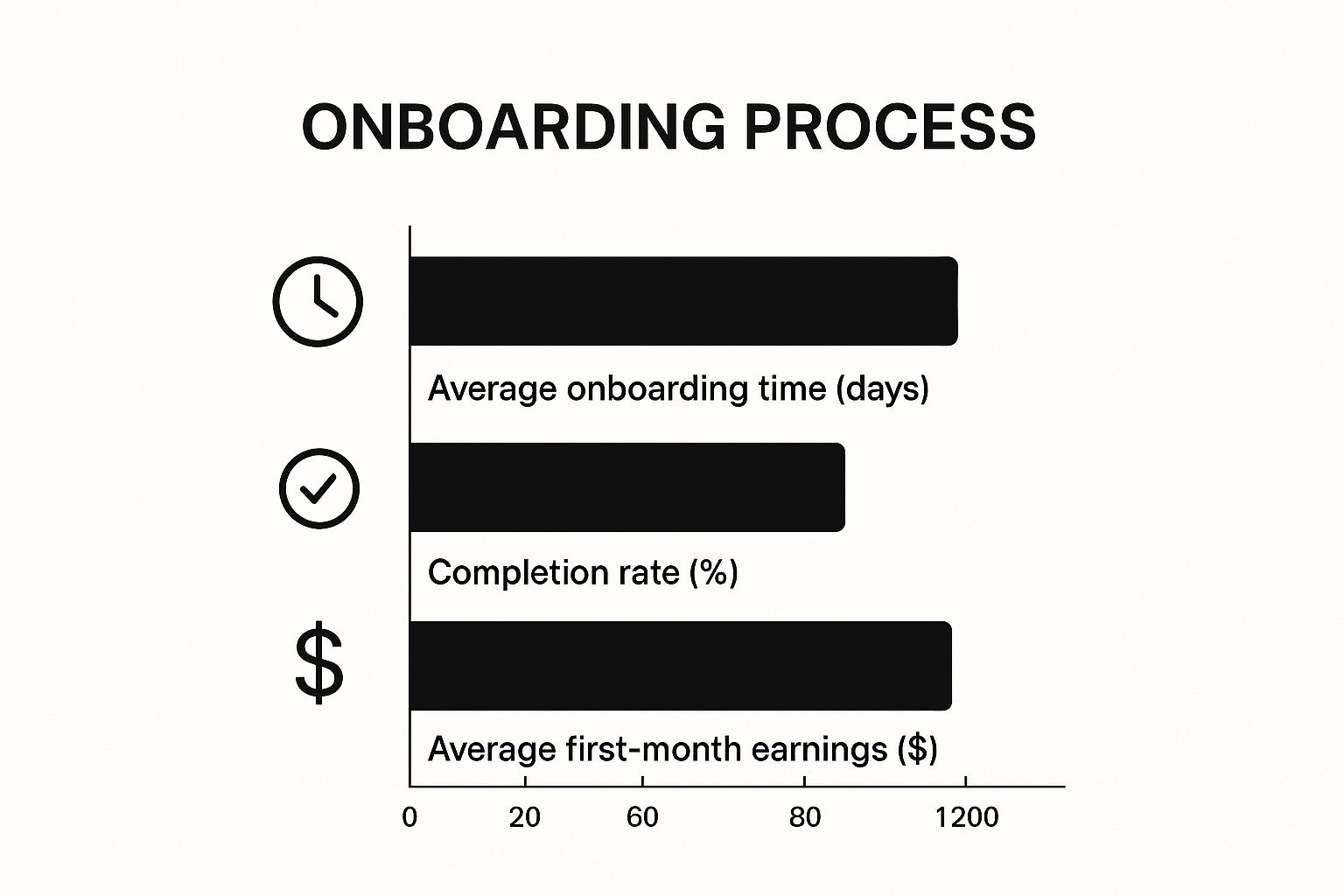Understanding The Current Affiliate Marketing Landscape
Before recruiting affiliates, it's crucial to understand the current affiliate marketing landscape. This rapidly expanding market offers a significant opportunity. Savvy recruiters are leveraging current trends to establish successful affiliate networks. This knowledge helps create appealing offers for potential partners.
The Expanding Affiliate Marketing Ecosystem
The affiliate marketing industry is booming, creating new ways for businesses to connect with potential customers. For example, existing programs are using micro-influencers to reach specialized markets. New technologies are simplifying affiliate management and tracking, allowing even small businesses to manage large affiliate networks effectively.
Market Trends and Regional Growth
Understanding market trends is vital for successful affiliate recruitment. Effective recruitment depends on recognizing the industry's substantial growth and market size. In 2022, the global affiliate marketing industry was valued at approximately $8.2 billion, a 10% year-over-year increase. Projections for 2024 soared to $21.1 billion, with continued growth anticipated to reach $36.9 billion by 2030. This rapid expansion highlights the growing importance of affiliate partnerships for businesses seeking to drive revenue.
North America dominates the market, representing over 40% of global affiliate marketing revenue. The U.S. serves as the world's largest affiliate marketing hub. You can find more detailed statistics here: Learn more about Affiliate marketing statistics.
This data underscores the need for strategic geographic targeting during affiliate recruitment. Specific regions are experiencing significant growth, providing substantial opportunities for businesses that focus their recruitment efforts strategically.
What This Means for Your Recruitment Approach
These market dynamics directly influence your affiliate recruitment strategy. If your target audience is primarily in North America, prioritizing recruiters in that region makes sense. However, emerging markets may offer untapped growth potential. This is where understanding regional trends becomes invaluable. By analyzing these patterns, you can identify and recruit affiliates best positioned to connect with your target audience, no matter their location. This focused approach optimizes your ability to build a successful, high-performing affiliate program.
Building Commission Structures That Attract Top Talent

Your commission structure is the foundation of a successful affiliate recruitment strategy. It's often the first thing prospective affiliates evaluate. Creating a compensation model that attracts top performers while maintaining profitability is critical. This requires understanding affiliate motivations and designing a structure that aligns with their goals.
Understanding Affiliate Motivations
Effective affiliate recruitment hinges on understanding what truly motivates affiliate marketers. While monetary compensation is a significant factor, it's not the only one. Top affiliates look for programs offering growth potential, reliable payouts, and a genuine sense of partnership. They want to feel valued and see a clear connection between their efforts and mutual success. This means providing resources and support necessary for them to excel.
Offering exclusive bonuses to top performers, for example, can significantly boost motivation and cultivate long-term partnerships. Providing high-quality marketing materials and dedicated support can greatly enhance their ability to promote your products effectively. Understanding affiliate marketer earnings and motivations also provides valuable insights. Data indicates the average affiliate marketer earns $8,038 per month, and an impressive 81.2% earn over $20,000 annually. Find more detailed statistics here. This data underscores the importance of competitive commissions and clearly communicating earning opportunities for effective recruitment.
Designing Competitive Commission Models
Developing a competitive commission structure requires research and planning. Benchmarking against competitors and analyzing industry standards is essential. However, simply matching the average commission rate isn't enough to set your program apart. You need to offer something more to attract the best talent.
Consider a tiered commission structure, where affiliates earn higher percentages as their sales volume grows. Performance-based bonuses, rewarding affiliates for achieving specific targets, can also be highly effective. Incorporating a mix of commission types, such as cost per acquisition (CPA), cost per lead (CPL), or revenue sharing, can be beneficial. This allows affiliates to select the model best suited to their strengths and marketing strategies.
Communicating Earning Potential
Clearly communicating your commission structure and earning potential is paramount. This information shouldn't be buried within your affiliate program details. Highlight it prominently on your affiliate landing page and in all outreach materials. Use straightforward language, avoiding complex terminology or calculations.
Showcasing potential earnings with practical examples can be particularly impactful. Illustrate how much an affiliate could earn at different performance levels. This helps potential partners visualize their earning potential, making your program more enticing. This transparency builds trust and demonstrates your commitment to a mutually beneficial partnership. By showcasing the potential for substantial income, you can attract and recruit high-performing affiliates. A well-designed commission plan not only attracts top talent but also fosters retention, contributing to the long-term success of your affiliate program.
Finding The Right Affiliates For Your Program

Attracting the right affiliates is crucial for a successful program. Not all affiliates contribute equally, so a strategic recruitment process is essential. This means finding prospects who truly align with your brand, target audience, and marketing message. This approach fosters productive partnerships that deliver tangible results. For those looking to get started, this article on How to get affiliates offers valuable insights.
Identifying Potential Affiliates
Effective affiliate recruitment goes beyond simply seeking individuals with large followings. True affiliate marketing success relies on finding partners who authentically connect with your target demographic. A beauty brand, for instance, might partner with makeup artists or skincare enthusiasts, while a SaaS company might collaborate with tech bloggers or industry experts.
Here are some key characteristics to look for:
- Audience Alignment: Does their audience share common ground with yours?
- Engagement Quality: Do they cultivate genuine interactions with their followers?
- Content Authenticity: Does their content resonate authentically with their audience and align with your brand values?
- Platform Relevance: Do they maintain an active presence on the platforms frequented by your target audience?
Effective Channels for Discovery
Discovering these ideal partners requires exploring a variety of channels. Diversifying your search efforts maximizes your reach and connects you with affiliates across various online spaces.
- Industry Networks: Platforms like ShareASale or CJ Affiliate provide access to networks of established affiliate marketers.
- Social Media: Utilize relevant hashtags and keywords to identify influencers and content creators on platforms like Instagram and Twitter.
- Competitor Research: Analyze your competitors' affiliate programs for insights into potential partners they've successfully engaged.
- Google Search: Search for blogs, websites, and forums related to your industry to uncover potential affiliate opportunities.
- Content Marketing Collaboration: Partner with creators on joint ventures to gauge audience engagement and assess compatibility.
Evaluating Potential Impact
Once you've identified potential affiliates, it's crucial to evaluate their potential impact. This means looking beyond vanity metrics like follower count and focusing on more substantial indicators.
Consider the following criteria:
- Engagement Rate: A high engagement rate signifies an active and responsive audience, suggesting stronger potential for conversion.
- Content Quality: High-quality content demonstrates expertise and professionalism, reflecting positively on your brand.
- Audience Demographics: Ensuring their audience aligns with your target market is essential for maximizing the effectiveness of your campaigns.
- Past Performance: If possible, research their history of collaborations and the results they've achieved for other brands.
To streamline your evaluation process, consider the following criteria:
The following table outlines key factors to consider when evaluating potential affiliates:
Affiliate Prospect Evaluation Criteria: A comparison of key factors to consider when evaluating potential affiliates for recruitment.
| Criteria | High Priority | Medium Priority | Low Priority | Red Flags |
|---|---|---|---|---|
| Audience Alignment | Strong overlap with target market | Some overlap | Minimal overlap | No relevant audience |
| Engagement Quality | High engagement rates, authentic interactions | Moderate engagement | Low engagement, spam comments | Fake followers, bought engagement |
| Content Authenticity | Genuine reviews, original content | Some sponsored content | Primarily promotional | Misleading or inaccurate information |
This table highlights the key criteria for evaluating potential affiliates and provides a clear framework for prioritizing prospects. By focusing on these factors, you can identify partners who possess a genuine capacity to connect with your audience.
By prioritizing prospects based on these factors, you're well on your way to building a successful affiliate program. This targeted approach ensures you recruit affiliates who can effectively represent your brand and drive meaningful results. Furthermore, considering cultural fit is paramount. This means selecting affiliates whose values align with your company's mission and messaging, fostering a stronger connection with your audience and encouraging long-term collaboration.
Creating Value Propositions That Actually Convert
Modern affiliates are looking for more than just a commission check. They're seeking partnerships that elevate their brand and provide genuine value to their audience. This requires a shift in perspective. Instead of viewing affiliates simply as revenue generators, recognize them as valuable partners in your business growth. This means crafting value propositions that resonate beyond monetary incentives.
Beyond the Commission: Offering Comprehensive Value
Consider offering exclusive product access, providing affiliates with early previews or special editions. Supplying them with high-quality marketing resources can also significantly enhance their promotional efforts. Think professionally designed banners, email templates, and social media assets. Equipping affiliates with these tools empowers them to successfully market your products or services. You can also explore partnering with existing affiliate programs to create a mutually beneficial arrangement. For example, check out myaifrontdesk’s article on Affiliate.
The impact of affiliate marketing on e-commerce transactions reinforces the importance of actively recruiting and nurturing affiliates. As of mid-2023, affiliate marketing drove 16% of U.S. e-commerce sales, showcasing the reliance on affiliate referrals. This influence is fueled by consistent market growth, averaging 10% year-over-year. Explore this topic further. This data underscores the need for businesses to not just recruit affiliates, but to cultivate these partnerships effectively.
Dedicated Support and Training: Fostering Long-Term Success
Providing dedicated support and training can significantly differentiate your program. Think of it as equipping your partners with the knowledge and resources they need to thrive. Just as a coach guides athletes, dedicated support for your affiliates can improve their performance and, ultimately, your program’s success. This could involve personalized onboarding, regular webinars, or access to a dedicated affiliate manager.
Demonstrating Impact: Showcasing the Value of Partnership
Finally, demonstrate the genuine impact affiliates have on your business growth. Showcase successful affiliate stories and highlight their contributions. This could involve featuring top performers on your website or sharing case studies of successful campaigns. By highlighting the achievements of existing affiliates, you attract new partners who seek a program that values and rewards their efforts. This creates a sense of community and shared success, fostering long-term loyalty and driving performance. Building a strong value proposition beyond monetary incentives positions your affiliate program as a true partnership, attracting and retaining top performers invested in your brand's success.
Outreach That Gets Responses And Builds Relationships

The infographic above illustrates the connection between onboarding time, completion rates, and first-month earnings for recruited affiliates. A streamlined onboarding process, shown by a shorter onboarding time, correlates with higher completion rates and better first-month earnings. This highlights the importance of a smooth and efficient onboarding experience to maximize affiliate success. This section explores strategic outreach and relationship building as key elements for recruiting successful affiliates. The difference between an ignored email and enthusiastic engagement often hinges on the approach.
Crafting Compelling Outreach Messages
Effective outreach starts with a compelling message. Generic pitches often get lost in the inbox. Personalization is crucial. Address potential affiliates by name, mention their specific work, and explain how your program aligns with their audience and content. For instance, if contacting a food blogger, reference a particular recipe or article that impressed you.
Communicating the value proposition of your affiliate program is also essential. Showcase competitive commission rates, bonus opportunities, and the support you provide. Present it like a job offer, highlighting the benefits to attract top talent.
Multi-Channel Approach: Expanding Your Reach
Using multiple channels increases your likelihood of connecting with high-quality prospects. Email remains a primary method, but consider supplementing it with social media engagement, direct messages, and even attending industry events.
Connecting with potential affiliates on platforms like Twitter and engaging with their content before sending a direct message can prove highly effective, especially when they consistently share valuable insights within your niche.
Building Relationships: From Initial Contact to Long-Term Partnership
Outreach is just the beginning. Building authentic relationships turns prospects into successful, long-term partners. Respond promptly to inquiries, provide personalized support, and foster open communication.
This involves actively engaging with your affiliates, offering constructive feedback, and acknowledging their achievements. Consider regular webinars or a dedicated forum for affiliates to connect and share best practices. A strong relationship built on trust and mutual respect encourages long-term loyalty and drives better performance.
To understand the performance of different outreach strategies, let's examine the following table:
Affiliate Outreach Channel Performance
This table summarizes the response rates and effectiveness of different recruitment channels for affiliate programs. It compares the average response rate, quality of leads generated, time investment required, and ideal use cases for each channel.
| Channel | Average Response Rate | Quality Score | Time Investment | Best For |
|---|---|---|---|---|
| 5-10% | Medium | Low | Initial contact, targeted campaigns | |
| Social Media (Direct Message) | 15-20% | High | Medium | Engaging with established influencers |
| Industry Events | 25-35% | High | High | Building personal connections, discovering new talent |
| Online Communities (Forums, Groups) | 10-15% | Medium | Medium | Reaching niche audiences, fostering discussions |
Key takeaways from this table indicate that while email is a good starting point, direct messaging on social media and attending industry events offer higher response rates and connect you with higher quality prospects. However, the time investment required for these channels is comparatively higher. Choosing the right mix of channels is crucial for a successful affiliate recruitment strategy.
Timing and Follow-Up: Maintaining Momentum
Strategic timing and consistent follow-up are essential to maximizing outreach success. The optimal time to connect depends on the platform and individual. Generally, avoiding weekends and sending emails during business hours is recommended.
Don't hesitate to follow up if you don't receive an immediate response. A polite follow-up email a few days later can re-engage a prospect. This persistence can significantly improve your chances of recruiting valuable affiliates. Learning how to recruit affiliates effectively depends on mastering these communication techniques.
Onboarding And Retaining Your Recruited Affiliates

Recruiting affiliates is only the first step. A truly successful program turns recruits into productive, long-term partners. This means an effective onboarding experience that sets them up for success and encourages continued engagement.
Welcome and Orientation: First Impressions Matter
A well-structured welcome is crucial. It’s the foundation of a strong partnership. Begin with a personalized welcome email. Reiterate your program's value and set clear expectations. Include important information like login details, program guidelines, and marketing materials.
Providing Valuable Training and Resources: Empowering Your Affiliates
Equipping your affiliates with the right knowledge and tools is paramount. Offer comprehensive training materials. These might include product guides, marketing best practices, and access to a dedicated affiliate manager. Providing creative assets such as banners and social media templates can also streamline their promotional efforts. This gives your partners what they need to effectively market your brand.
Ongoing Communication and Support: Building Long-Term Relationships
Once your affiliates are on board, focus on building strong relationships. For more insights, you can learn about connecting with influencers. Open communication and ongoing support are critical for retention. Regular newsletters, performance updates, and feedback opportunities help create a sense of community. This keeps affiliates informed, motivated, and invested in your brand’s growth. Our guide on How to Master Affiliate Program Management offers further strategies for nurturing these essential relationships.
Performance Feedback and Incentives: Driving Continuous Improvement
Regular performance feedback helps drive improvement. Share performance data with your affiliates, highlighting strengths and areas for optimization. This feedback should be constructive and actionable, providing specific tips to increase conversions and earnings. Consider performance-based incentives, like bonuses or tiered commissions, to reward high achievers. This encourages ongoing success and fosters a culture of growth. It demonstrates the value of their contributions and positions your program as a collaborative partnership.
Key Takeaways
This section offers a practical guide to successful affiliate recruitment. We'll explore proven strategies, clear implementation steps, and actionable checklists. Each takeaway focuses on immediate action, measurable results, and areas for ongoing optimization. We'll also address common challenges and set realistic expectations for achieving your goals.
Understanding the Affiliate Landscape
Before recruiting affiliates, it's essential to understand the current affiliate marketing landscape. Research industry trends, regional growth patterns, and how these factors influence your recruitment strategy. For example, recognizing North America's significant role in affiliate marketing might guide where you concentrate your recruitment efforts. Understanding these dynamics allows you to tailor your recruitment process for maximum impact.
Building a Compelling Commission Structure
Your commission structure is fundamental to attracting and retaining affiliates. Develop a compensation plan that attracts high-performing affiliates while maintaining profitability. Research competitive rates, consider performance bonuses, and explore tiered structures to incentivize higher sales volumes. For example, offering increased commission rates for surpassing specific sales targets encourages affiliates to drive more revenue. A well-structured commission plan is key to a successful program. For more detailed information, take a look at our guide on calculating your potential affiliate program ROI.
Identifying and Evaluating Potential Affiliates
Effective recruitment involves finding the right affiliates for your business. Look beyond superficial metrics like follower count. Prioritize engagement quality, audience alignment, and content authenticity. Think of it as building a team; you want members who are a good fit and contribute positively. Use a checklist to evaluate key factors such as platform relevance, audience demographics, and content quality. This focused approach ensures you recruit affiliates who genuinely connect with your brand and target audience.
Crafting a Value Proposition That Converts
Today's affiliates are looking for more than just commission payments. They want partnerships that contribute to their own success. Offer exclusive product access, valuable marketing resources, dedicated support, and comprehensive training. These added benefits position your program as a true partnership, not just another revenue stream. Providing valuable resources and support demonstrates your commitment to mutual success.
Effective Outreach and Relationship Building
Outreach is essential for connecting with potential affiliates. A personalized approach resonates more effectively than a generic message. Mention their specific work, explain how your program aligns with their audience, and clearly outline the benefits. Treat outreach like networking; genuine interaction builds stronger relationships. Follow up after initial contact to maintain momentum and demonstrate genuine interest. Consistent, valuable communication can transform initial outreach into lasting partnerships.
Onboarding and Retaining Affiliates
Successful recruitment is the first step. Onboard new affiliates effectively with clear program guidelines, welcome packets, and ready access to essential resources. This establishes a strong foundation for a productive partnership. Consistent communication, performance feedback, and ongoing support are vital for retention. Regular check-ins and performance updates help keep affiliates motivated and demonstrate your investment in their success. Building a sense of community among your affiliates fosters belonging and collaboration.
Realistic Timelines and Measuring Success
Building a thriving affiliate program takes time. Don't expect instant results; consistent effort and ongoing optimization are crucial. Track key performance indicators (KPIs) such as conversion rates, average order value, and customer lifetime value to measure program effectiveness. Analyzing this data allows you to identify areas for improvement and refine your strategies over time. Regular review and adjustments ensure your program stays on track and delivers consistent results.
Ready to transform your SaaS user base into a revenue-generating affiliate network? Refgrow is the seamlessly embeddable affiliate software designed to accelerate your growth. Launch your affiliate program with Refgrow today!

